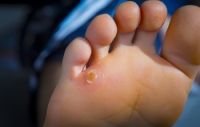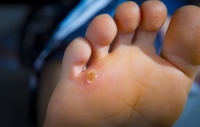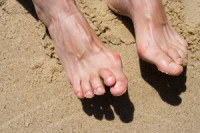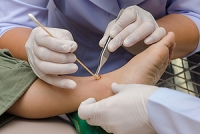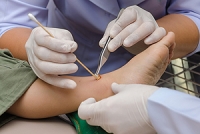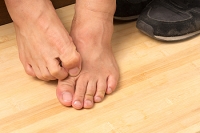
Blog (791)
Are You Suffering From Ingrown Toenails?
Are You Suffering From Ingrown Toenails?
What Are Corns?
A corn is a hard, thick patch of skin that develops in response to pressure or friction, usually caused by wearing ill-fitting shoes. When the skin in a concentrated area on the foot is compressed, it can harden, forming a corn. Corns involve not only a hardened outer layer of skin, but also hardening of deeper tissues within the foot. Sometimes, the layers of skin and tissue can harden all the way down to the bone. There are two types of corns. Hard corns are usually located on the tops of the smaller toes, while soft corns are usually located between the toes. Both types of corns may become inflamed and cause pain, especially when they are pressed on. If you notice that you have a corn, it is suggested that you seek the care of a podiatrist who can offer you the proper treatments.
Corns can make walking very painful and should be treated immediately. If you have questions regarding your feet and ankles, contact Dr. Kenneth Donovan of Advanced Care Foot and Ankle. Our doctor will treat your foot and ankle needs.
Corns: What Are They? And How Do You Get Rid of Them?
Corns are thickened areas on the skin that can become painful. They are caused by excessive pressure and friction on the skin. Corns press into the deeper layers of the skin and are usually round in shape.
Ways to Prevent Corns
There are many ways to get rid of painful corns such as:
- Wearing properly fitting shoes that have been measured by a professional
- Wearing shoes that are not sharply pointed or have high heels
- Wearing only shoes that offer support
Treating Corns
Although most corns slowly disappear when the friction or pressure stops, this isn’t always the case. Consult with your podiatrist to determine the best treatment option for your case of corns.
If you have any questions please feel free to contact one of our offices located in Warren, Livingston, and Toms River, NJ . We offer the newest diagnostic and treatment technologies for all your foot and ankle needs.
Read more about Corns: What Are They, and How Do You Get Rid of Them
What Are Corns?
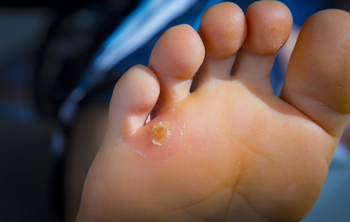 A corn is a hard, thick patch of skin that develops in response to pressure or friction, usually caused by wearing ill-fitting shoes. When the skin in a concentrated area on the foot is compressed, it can harden, forming a corn. Corns involve not only a hardened outer layer of skin, but also hardening of deeper tissues within the foot. Sometimes, the layers of skin and tissue can harden all the way down to the bone. There are two types of corns. Hard corns are usually located on the tops of the smaller toes, while soft corns are usually located between the toes. Both types of corns may become inflamed and cause pain, especially when they are pressed on. If you notice that you have a corn, it is suggested that you seek the care of a podiatrist who can offer you the proper treatments.
A corn is a hard, thick patch of skin that develops in response to pressure or friction, usually caused by wearing ill-fitting shoes. When the skin in a concentrated area on the foot is compressed, it can harden, forming a corn. Corns involve not only a hardened outer layer of skin, but also hardening of deeper tissues within the foot. Sometimes, the layers of skin and tissue can harden all the way down to the bone. There are two types of corns. Hard corns are usually located on the tops of the smaller toes, while soft corns are usually located between the toes. Both types of corns may become inflamed and cause pain, especially when they are pressed on. If you notice that you have a corn, it is suggested that you seek the care of a podiatrist who can offer you the proper treatments.
Corns can make walking very painful and should be treated immediately. If you have questions regarding your feet and ankles, contact Dr. Kenneth Donovan of Advanced Care Foot and Ankle. Our doctor will treat your foot and ankle needs.
Corns: What Are They? And How Do You Get Rid of Them?
Corns are thickened areas on the skin that can become painful. They are caused by excessive pressure and friction on the skin. Corns press into the deeper layers of the skin and are usually round in shape.
Ways to Prevent Corns
There are many ways to get rid of painful corns such as:
- Wearing properly fitting shoes that have been measured by a professional
- Wearing shoes that are not sharply pointed or have high heels
- Wearing only shoes that offer support
Treating Corns
Although most corns slowly disappear when the friction or pressure stops, this isn’t always the case. Consult with your podiatrist to determine the best treatment option for your case of corns.
If you have any questions please feel free to contact one of our offices located in Warren, Livingston, and Toms River, NJ . We offer the newest diagnostic and treatment technologies for all your foot and ankle needs.
What Is Wrong With My Toe?
If you have noticed your second, third, or fourth toe has begun to bend in a downward shape, you may have a hammertoe. A hammertoe typically starts out as a mild deformity, however if left untreated, it can worsen over time and become more rigid. When a hammertoe is too rigid, non-surgical treatments such as a custom orthotic, may no longer be a viable option. Hammertoes can develop due to a muscle or tendon imbalance, as well as a previous trauma to the affected toe. For a proper diagnosis, please consult with a podiatrist.
Hammertoe
Hammertoes can be a painful condition to live with. For more information, contact Dr. Kenneth Donovan from Advanced Care Foot and Ankle. Our doctor will answer any of your foot- and ankle-related questions.
Hammertoe is a foot deformity that affects the joints of the second, third, fourth, or fifth toes of your feet. It is a painful foot condition in which these toes curl and arch up, which can often lead to pain when wearing footwear.
Symptoms
- Pain in the affected toes
- Development of corns or calluses due to friction
- Inflammation
- Redness
- Contracture of the toes
Causes
Genetics – People who are genetically predisposed to hammertoe are often more susceptible
Arthritis – Because arthritis affects the joints in your toes, further deformities stemming from arthritis can occur
Trauma – Direct trauma to the toes could potentially lead to hammertoe
Ill-fitting shoes – Undue pressure on the front of the toes from ill-fitting shoes can potentially lead to the development of hammertoe
Treatment
Orthotics – Custom made inserts can be used to help relieve pressure placed on the toes and therefore relieve some of the pain associated with it
Medications – Oral medications such as anti-inflammatories or NSAIDs could be used to treat the pain and inflammation hammertoes causes. Injections of corticosteroids are also sometimes used
Surgery – In more severe cases where the hammertoes have become more rigid, foot surgery is a potential option
If you have any questions please contact one of our offices located in Warren, Livingston, and Toms River, NJ. We offer the newest diagnostic and treatment technologies for all your foot and ankle needs.
Why Are Diabetics More Susceptible to Foot Wounds?
Foot wounds or foot ulcers can become serious issues for diabetics. About 15% of people with diabetes will develop wounds on their feet. These wounds may be difficult to detect and are typically slow to heal. Many diabetics suffer from peripheral neuropathy, a loss of sensation in the lower limbs. This loss of sensation makes it hard to know if you have injured your foot. A cut, scrape, sore, or a more serious injury like a burn or puncture, can go undetected. The lack of awareness of the injury can be a big problem because diabetics also frequently suffer from poor circulation to the lower limbs. Poor circulation leads to slower healing and can make you more prone to infection. If you have diabetes, it is important to inspect your feet for wounds daily and to get treatment for your wounds as soon as possible. A podiatrist can help you care for your feet and offer treatment and prevention strategies that will work for you.
Wound care is an important part in dealing with diabetes. If you have diabetes and a foot wound or would like more information about wound care for diabetics, consult with Dr. Kenneth Donovan from Advanced Care Foot and Ankle. Our doctor will assess your condition and provide you with quality foot and ankle treatment.
What Is Wound Care?
Wound care is the practice of taking proper care of a wound. This can range from the smallest to the largest of wounds. While everyone can benefit from proper wound care, it is much more important for diabetics. Diabetics often suffer from poor blood circulation which causes wounds to heal much slower than they would in a non-diabetic.
What Is the Importance of Wound Care?
While it may not seem apparent with small ulcers on the foot, for diabetics, any size ulcer can become infected. Diabetics often also suffer from neuropathy, or nerve loss. This means they might not even feel when they have an ulcer on their foot. If the wound becomes severely infected, amputation may be necessary. Therefore, it is of the upmost importance to properly care for any and all foot wounds.
How to Care for Wounds
The best way to care for foot wounds is to prevent them. For diabetics, this means daily inspections of the feet for any signs of abnormalities or ulcers. It is also recommended to see a podiatrist several times a year for a foot inspection. If you do have an ulcer, run the wound under water to clear dirt from the wound; then apply antibiotic ointment to the wound and cover with a bandage. Bandages should be changed daily and keeping pressure off the wound is smart. It is advised to see a podiatrist, who can keep an eye on it.
If you have any questions, please feel free to contact one of our offices located in Warren, Livingston, and Toms River, NJ . We offer the newest diagnostic and treatment technologies for all your foot care needs.
Why Are Diabetics More Susceptible to Foot Wounds?
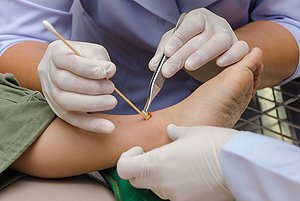 Foot wounds or foot ulcers can become serious issues for diabetics. About 15% of people with diabetes will develop wounds on their feet. These wounds may be difficult to detect and are typically slow to heal. Many diabetics suffer from peripheral neuropathy, a loss of sensation in the lower limbs. This loss of sensation makes it hard to know if you have injured your foot. A cut, scrape, sore, or a more serious injury like a burn or puncture, can go undetected. The lack of awareness of the injury can be a big problem because diabetics also frequently suffer from poor circulation to the lower limbs. Poor circulation leads to slower healing and can make you more prone to infection. If you have diabetes, it is important to inspect your feet for wounds daily and to get treatment for your wounds as soon as possible. A podiatrist can help you care for your feet and offer treatment and prevention strategies that will work for you.
Foot wounds or foot ulcers can become serious issues for diabetics. About 15% of people with diabetes will develop wounds on their feet. These wounds may be difficult to detect and are typically slow to heal. Many diabetics suffer from peripheral neuropathy, a loss of sensation in the lower limbs. This loss of sensation makes it hard to know if you have injured your foot. A cut, scrape, sore, or a more serious injury like a burn or puncture, can go undetected. The lack of awareness of the injury can be a big problem because diabetics also frequently suffer from poor circulation to the lower limbs. Poor circulation leads to slower healing and can make you more prone to infection. If you have diabetes, it is important to inspect your feet for wounds daily and to get treatment for your wounds as soon as possible. A podiatrist can help you care for your feet and offer treatment and prevention strategies that will work for you.
Wound care is an important part in dealing with diabetes. If you have diabetes and a foot wound or would like more information about wound care for diabetics, consult with Dr. Kenneth Donovan from Advanced Care Foot and Ankle. Our doctor will assess your condition and provide you with quality foot and ankle treatment.
What Is Wound Care?
Wound care is the practice of taking proper care of a wound. This can range from the smallest to the largest of wounds. While everyone can benefit from proper wound care, it is much more important for diabetics. Diabetics often suffer from poor blood circulation which causes wounds to heal much slower than they would in a non-diabetic.
What Is the Importance of Wound Care?
While it may not seem apparent with small ulcers on the foot, for diabetics, any size ulcer can become infected. Diabetics often also suffer from neuropathy, or nerve loss. This means they might not even feel when they have an ulcer on their foot. If the wound becomes severely infected, amputation may be necessary. Therefore, it is of the upmost importance to properly care for any and all foot wounds.
How to Care for Wounds
The best way to care for foot wounds is to prevent them. For diabetics, this means daily inspections of the feet for any signs of abnormalities or ulcers. It is also recommended to see a podiatrist several times a year for a foot inspection. If you do have an ulcer, run the wound under water to clear dirt from the wound; then apply antibiotic ointment to the wound and cover with a bandage. Bandages should be changed daily and keeping pressure off the wound is smart. It is advised to see a podiatrist, who can keep an eye on it.
If you have any questions, please feel free to contact one of our offices located in Warren, Livingston, and Toms River, NJ . We offer the newest diagnostic and treatment technologies for all your foot care needs.
Do Your Child’s Feet Hurt?
Do Your Child's Feet Hurt?
Children and Athlete’s Foot
A noticeable sign that your child may have athlete’s foot can be scratching on the bottom of the foot and between the toes. This type of fungus generally causes the skin to become red and scaly, and the affected foot may emit an odor. In severe cases, this condition can produce a rash, and your child may complain of a burning and tingling sensation. Athlete’s foot is contagious, and can develop as a result of frequenting public swimming pools, locker rooms, and surrounding areas. If your child has this condition, it is suggested that you consult with a podiatrist who can prescribe medication for relief.
Athlete’s foot is an inconvenient condition that can be easily reduced with the proper treatment. If you have any concerns about your feet and ankles, contact Dr. Kenneth Donovan from Advanced Care Foot and Ankle.
Our doctor will treat your foot and ankle needs.
Athlete’s Foot: The Sole Story
Athlete's foot, also known as tinea pedis, can be an extremely contagious foot infection. It is commonly contracted in public changing areas and bathrooms, dormitory style living quarters, around locker rooms and public swimming pools, or anywhere your feet often come into contact with other people.
Solutions to Combat Athlete’s Foot
- Hydrate your feet by using lotion
- Exfoliate
- Buff off nails
- Use of anti-fungal products
- Examine your feet and visit your doctor if any suspicious blisters or cuts develop
Athlete’s foot can cause many irritating symptoms such as dry and flaking skin, itching, and redness. Some more severe symptoms can include bleeding and cracked skin, intense itching and burning, and even pain when walking. In the worst cases, Athlete’s foot can cause blistering as well. Speak to your podiatrist for a better understanding of the different causes of Athlete’s foot, as well as help in determining which treatment options are best for you.
If you have any questions please feel free to contact one of our offices located in Warren, Livingston, and Toms River, NJ . We offer the newest diagnostic and treatment technologies for all your foot and ankle needs.



